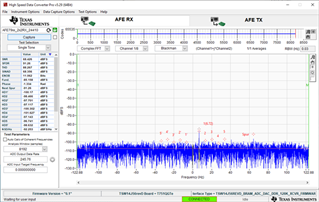Hi,
Currently I am using AFE7950EVM with TSW14J56 capture card to evaluate the ADC. I have followed the steps mentioned in user guide for HSDC pro and Latte script. In the log window it is showing that link is established between both the boards (also confirmed from the status LED D2 and D4 blinking). But while sending the tone from HSDC pro DAC tab and capturing the same from ADC tab nothing appears. In addition to this I am unable to observe this tone on spectrum analyzer.
Why this much of low output level?


